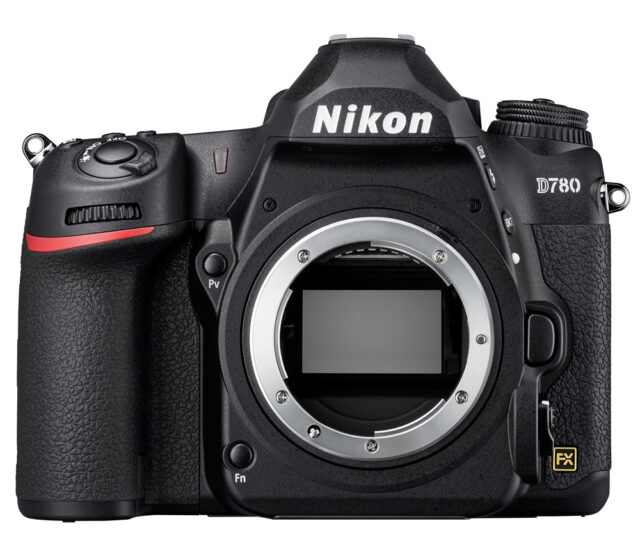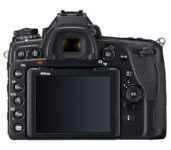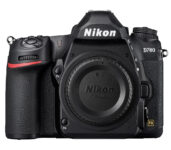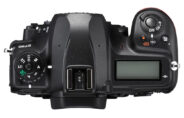Announced
Production status
System
Nikon F system cameras
- Nikkorex F
- Nikkormat EL
- Nikkormat ELW
- Nikkormat FS
- Nikkormat FT
- Nikkormat FT2
- Nikkormat FT3
- Nikkormat FTN
- Nikon D3
- Nikon D3s
- Nikon D3X
- Nikon D4
- Nikon D4s
- Nikon D5
- Nikon D6
- Nikon D600
- Nikon D610
- Nikon D700
- Nikon D750
- Nikon D780
- Nikon D800
- Nikon D800E
- Nikon D810
- Nikon D850
- Nikon Df
- Nikon EL2
- Nikon EM
- Nikon F
- Nikon F100
- Nikon F2
- Nikon F3
- Nikon F4
- Nikon F5
- Nikon F6
- Nikon FA
- Nikon FE
- Nikon FE10
- Nikon FE2
- Nikon FG
- Nikon FG-20
- Nikon FM
- Nikon FM10
- Nikon FM2
- Nikon FM2/T
- Nikon FM3A
- Nikon N2000
- Nikon N2020
- Nikon N4004
- Nikon N4004S
- Nikon N50
- Nikon N5005
- Nikon N55
- Nikon N60
- Nikon N6000
- Nikon N6006
- Nikon N65
- Nikon N70
- Nikon N75
- Nikon N80
- Nikon N8008
- Nikon N8008S
- Nikon N90
- Nikon N90S
Nikon D780
35mm AF digital SLR camera
Specification
| Format: | |
| 35mm full frame | |
Imaging sensor: | 35.9 × 23.9mm CMOS sensor |
Resolution: | 6048 × 4024 - 24 MP |
Sensor-shift image stabilization: | - |
| Nikon F [46.5mm] | |
| Shutter: | |
Type: | Focal-plane |
Model: | Electronically controlled |
Speeds: | 900 - 1/8000 + B |
| Exposure: | |
Exposure metering: | Through-the-lens (TTL), open-aperture |
Exposure modes: | Programmed Auto |
| Aperture-priority Auto | |
| Shutter-priority Auto | |
| Manual | |
| Physical characteristics: | |
Weight: | 840g |
Dimensions: | 143.5x115.5x76mm |
Manufacturer description
TOKYO - Nikon Corporation (Nikon) is pleased to announce the release of the Nikon D780, a Nikon FX-format digital SLR camera.
Succeeding the Nikon D750 (released in September 2014), the D780 is a high-performance digital SLR featuring a number of superior functions inherited from professional models, starting with its advanced autofocusing (AF) system for which 51 focus points have been adopted for viewfinder shooting. Additionally, the D780 is Nikon's first digital SLR employing the hybrid AF system for live view mode used by Nikon Z series cameras. This further demonstrates the next step up in AF performance with both viewfinder and live view shooting.
The 51-point AF system utilized with viewfinder shooting, that uses phase-detection AF technology, inherits the AF algorithm from Nikon's flagship D-SLR model — the D5 (released in March 2016). The algorithm, together with other innovations, is optimized for the D780 to achieve greater subject detection and tracking performance. The D780 is also the first Nikon digital SLR to utilize focal-plane phase-detection AF. The hybrid AF system, which automatically switches between focal-plane phase-detection AF and contrast-detect AF in accordance with the situation and conditions, covers approximately 90% of the frame when used with live view photography and movie recording. This applies both horizontally and vertically, with 273*1 focus points. In addition to demonstrating smooth and precise tracking performance while movie recording, the hybrid AF system supports Eye-detection AF*2, which automatically detects human eyes with still photography, greatly increasing flexibility with portrait photography. The D780 makes smooth and natural autofocusing possible with a wide variety of scenes — whether using the viewfinder or the monitor to frame stills and movies.
The camera features an effective pixel count of 24.5 million pixels, and utilizes a backside illumination CMOS sensor that is itself equipped with focal-plane phase-detection AF pixels. This, used in combination with the EXPEED 6 image-processing engine, realizes excellent high-sensitivity performance at the maximum standard sensitivity setting of ISO 51200. Even at higher sensitivity settings, noise is effectively reduced to preserve sharp and clear images. The D780 also supports recording of 4K UHD movies with high dynamic range utilizing the HDR (Hybrid Log-Gamma) standard. Shutter speeds of 1/8000 s to a minimum of 900 s (15 min.)*3 can be specified. In addition, the camera's buffer has been expanded to enable capture of approximately four times as many shots in 14-bit lossless compressed RAW (up to approx. 68*4) with a single burst of high-speed continuous shooting at approximately 7 fps*5 as was possible with the D750.
The D780 is a camera that will inspire those looking to demonstrate their creativity in a variety of ways to be even more creative through the great diversity in its capabilities — from the ability to photograph rapidly moving subjects, to portrait photography utilizing Eye-detection AF, and recording of HDR (HLG) movies that exhibit rich tones and gradations.
Primary Features
1. Improved AF performance that supports a wide variety of scenes
A 51-point AF system that captures the intended subject with great accuracy and precision
The AF system has been greatly improved since the D750, especially when it comes to autofocusing performance with viewfinder shooting. The powerful calculation capability realized by the EXPEED 6 image-processing engine, as well as the detailed subject information acquired by the Advanced Scene Recognition System and upgraded 180K-pixel RGB sensors contribute to enhanced subject tracking in 3D-tracking mode. In combination with the AF algorithm adapted from the D5, these technologies also contribute to improved subject detection in the auto-area mode, enabling the capture of intended subjects with even greater accuracy.
A 273-point hybrid AF system that utilizes focal-plane phase-detection AF and supports Eye-detection AF
The D780 is the first Nikon digital SLR for which focal-plane phase-detection AF has been adopted. This represents a tremendous evolution in AF performance with live view photography and movie recording. The hybrid AF system, which automatically switches between focal-plane phase-detection AF and contrast-detect AF in accordance with the situation and conditions, covers approximately 90% of the frame, both horizontally and vertically, with 273 focus points. This makes it easy for the camera to focus on subjects at the edges of the frame. The D780 also supports Eye-detection AF, with which the camera accurately recognizes human eyes even when the person is moving, when using the live view photography in auto-area AF mode. This ensures certain focus on the subject's eyes with portraits and the like, allowing the photographer to comfortably concentrate on framing their images. What's more, AF speed* and AF tracking sensitivity with movie recording can be adjusted, enabling smooth autofocusing in accordance with the creative intention.
*AF speed cannot be adjusted when certain lenses are used.
2. High-quality stills and movies exhibiting superior high-sensitivity performance with very little noise
An effective pixel count of 24.5 million pixels and a backside illumination CMOS sensor, itself equipped with focal-plane phase-detection AF pixels, have been adopted for the D780. This, in combination with adoption of the EXPEED 6 image-processing engine, realizes excellent high-sensitivity performance at the maximum standard sensitivity setting of ISO 51200* with optimal balance between preserving sharpness and clarity, while effectively reducing noise, even at high sensitivities. The camera is also capable of recording not only full-frame 4K UHD/30p movies, but also full-HD/120p movies. Further, high dynamic range (HDR) movies can be recorded using the hybrid log-gamma (HLG) standard during 10-bit HDMI output, producing beautiful video with rich tones and gradations that faithfully reproduce every detail in high-contrast scenes, all without post-recording color grading.
*ISO sensitivity can be expanded down to the equivalent of ISO 50 and up to the equivalent of ISO 204800.
3. Performance and functions that support diverse imaging expression
The D780 supports high-speed continuous shooting at up to approximately 7 fps with both viewfinder shooting and live view photography. Expansion of the camera's memory buffer enables capture of approximately four times as many shots (up to approx. 68) with a single burst of high-speed continuous shooting of large,14-bit lossless compressed RAW files as was possible with the D750, ensuring that users never miss a photo opportunity. What's more, a broad range of shutter speeds, from the fastest at 1/8000 s to the longest at 900 s, is available. In addition to effectively capturing rapidly moving subjects, combining the 1/8000 s maximum shutter speed with the maximum apertures provided by fast lenses enables capture of stunning portraits, even under extremely bright, sunlit conditions. The slowest shutter speed setting available — 900 s — is perfect for astrophotography and other long time-exposures.
The D780 is also equipped with movie-recording functions that respond extremely well to user needs, including a function for automatically recording slow-motion movies at 4x or 5x the normal recording speed, as well as Nikon's exclusive N-Log* option for use with 10-bit HDMI output.
*Footage is recorded only to the external device; it cannot be recorded to the memory card inserted in the camera.
4. Superior reliability and operability that make the camera effective with a broader range of photographic scenes
The camera body has a monocoque structure with which a magnesium alloy has been adopted for the top and rear covers, ensuring superior rigidity and durability with a lighter weight. Each part of the camera has been effectively sealed for reliable dust and drip resistance. Operation has also been improved with careful consideration of button and control positioning and a grip that ensures a firm and steady hold.
A power-saving design enables capture of approximately 2,260 frames (measured in accordance with CIPA standard) on a single charge, providing worry-free shooting over an extended period of time. In addition, a 3.2-in., 2,359k-dot LCD touch screen has been adopted for the tilting monitor equivalent to that used by the Nikon D850 (released in September 2017), enabling diverse touch operation. The D780 responds to a variety of scenes and conditions with superior reliability and operability that realize comfortable and intuitive shooting.
5.Additional features
- Improved AF fine-tune for greater focus accuracy when zoom lenses are used
- An electronic shutter that enables silent photography with no shutter sounds or mechanical blur
- Active D-Lighting, electronic vibration reduction, and focus peaking can be used with 4K UHD movie recording
- In-camera, automatic time-lapse movie production in the interval-timer photography mode allows users to view the resulting movie immediately after shooting
- High-speed Frame Capture*1 of 2-megapixel images at up to 120 fps (when Full-HD movie recording selected) and 8-megapixel images at up to 30 fps (when 4K-UHD movie recording selected), both with AF/AE tracking
- Dual SD card slots that support simultaneous deletion of original and backup images
- Support for the next evolution of the SnapBridge app; Ver. 2.6 enables the transfer of RAW images to a smart device*2, filtering settings, and remote camera operation over a Bluetooth® connection
- A negative digitizer that makes it easy to convert color or black-and-white film negatives (35mm [135]) to digital data (JPEG) using the ES-2 Film Digitizing Adapter (optional)
Similar cameras (2)
35mm full frame • Auto focus • Digital • Singe-lens reflex • Nikon F mount
| Model | Shutter | Metering | Modes | Year |
|---|---|---|---|---|
| Kodak DCS Pro 14n | E, 1/4000 | TTL • OA | PASM | 2002 ● |
| Kodak DCS Pro SLR/n | E, 1/4000 | TTL • OA | PASM | 2004 ● |



